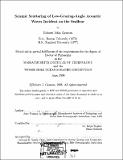Seismic scattering of low-grazing-angle acoustic waves incident on the seafloor
Author(s)
Greaves, Robert J
DownloadFull printable version (40.60Mb)
Advisor
Ralph Stephen.
Terms of use
Metadata
Show full item recordAbstract
The goal of this thesis is to develop a methodology to interpret sound scattered from the seafloor in terms of seafloor structure and subseafloor geological properties. Specifically, this work has been directed towards the interpretation of matched-filtered, beam-formed monostatic acoustic reverberation data acquired on the west flank of the Mid-Atlantic Ridge when the seafloor is insonified by a band-limited, lowgrazing- angle acoustic pulse. This research is based on the hypothesis that observed backscatter signals are produced by a combination.of seafloor (interface) scattering and subseafloor (volume) scattering from structure having variations at scale lengths similar to the wavelength of the insonifying acoustic field. Analysis of monostatic reverberation data acquired during the Site A experiment (Run 1) of the Acoustic Reverberation Special Research Program 1993 Acoustics Cruise suggests that the scattered signals cannot be accounted for quantitatively in terms of large-scale slope, even though a strong correspondence between high intensity backscatter and seafloor ridges is observed. In order to investigate and quantify the actual sources of seafloor scattering, a numerical modeling study of seafloor models is undertaken using a finitedifference solution to the elastic wave equation. Geological data available at Site A and published reports describing geological properties of similar deep ocean crustal regions are used to develop a realistic seafloor model for the study area with realistic constraints on elastic parameters. Wavelength-scale heterogeneity in each model, in the form of seafloor roughness and subseafloor volume heterogeneity is defined using stochastic distributions with Gaussian autocorrelations. These distributions are quantified by their correlation lengths and standard deviation in amplitude. In order to incorporate all seafloor structure in a single parameterization of seafloor scattering, large-scale slope and wavelength-scale seafloor spatial parameters (rms height and correlation length), are included, along with the acoustic beam grazing-angle relative to a horizontal seafloor, in the definition of an 'effective grazing angle'. The Rayleigh roughness parameter, which depends on grazing angle of the insonification, is then redefined using the effective grazing angle and calculated for a variety of seafloor models. Scattering strengths are shown to vary systematically but nonlinearly with the 'effective Rayleigh roughness parameters' of horizontal rough seafloor models. This leads to an approximate interpretation scheme for backscatter intensity. In general, variation in backscattering is found to be dominated by the scattering from rough seafloor. If the seafloor is smooth or very low velocity (e.g., sediment), then scattering from volume heterogeneity becomes an important factor in the backscattered field. Both wavelength-scale seafloor roughness and volume heterogeneity are shown to be capable of producing the levels of variation in intensity observed in monostatic reverberation experiments. Variations in large-scale seafloor slope and subseafloor average velocity are shown to influence the backscatter response of seafloor models.
Description
Thesis (Ph. D.)--Joint Program in Oceanography (Massachusetts Institute of Technology, Dept. of Earth, Atmospheric, and Planetary Sciences; and the Woods Hole Oceanographic Institution), 1998. Includes bibliographical references (v. 2, leaves 423-433).
Date issued
1998Department
Joint Program in Oceanography; Massachusetts Institute of Technology. Department of Earth, Atmospheric, and Planetary Sciences; Woods Hole Oceanographic Institution; Massachusetts Institute of Technology. Department of Ocean EngineeringPublisher
Massachusetts Institute of Technology
Keywords
Joint Program in Oceanography., Massachusetts Institute of Technology. Dept. of Earth, Atmospheric, and Planetary Sciences., Woods Hole Oceanographic Institution.